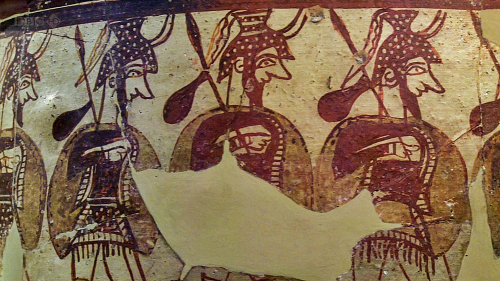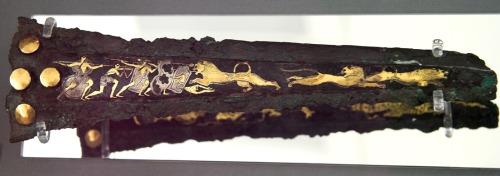#national archaeological museum athens
Ancient Worlds - BBC Two
Episode 1 “Come Together”
KraterfromMycenae,Greece, known as the Warrior Vase.
Late Helladic period (late Bronze Age), 1200-1100 BC.
The painted terracotta vase was found by Heinrich Schliemann on the acropolis of Mycenae. During the 1870s Schliemann excavated the ancient Shaft Graves, a royal cemetery, where he discovered spectacular grave goods.
The large vase depicts a group of heavily armed warriors (helmet, cuirass, greaves, shield and spear) as they depart for war, a sack of supplies hanging from their spears. A woman, standing to one side, bids them farewell. It is one of the best known examples of Mycenaean Pictorial style
Ancient greeks used kraters to mix wine and water.
National Archaeological Museum, Athens, Greece
Post link
Ancient Worlds - BBC Two
Episode 2 “The Age of Iron”
“Lion Hunt dagger”. Bronze dagger inlaid with silver and gold from Mycenae.
The dagger is decorated with a scene depicting warriors with spears and shields fighting lions. It was found in Shaft Grave IVofGrave Circle A at Mycenae and it’s dated to the 16th century BC- Late Bronze Age.
Grave Circle A was part of a large cemetery outside Mycenae’s acropolis walls. It comprises six shaft graves, where nineteen bodies were buried. The wealth of the grave gifts reveals the high social rank of the deceased: gold jewelry and vases, gold death masks, decorated swords, bronze objects and artefacts made of imported materials like amber, lapis lazuli and ostrich eggs. The large number of weapons found shows that some of the dead were very good an important warriors. The site was excavated by the archaeologist Heinrich Schliemann in 1876.
The dagger was not used in actual warfare but held importance as decorative burial good for a powerful and wealthy Mycenaean citizen. The golden artwork on the dagger reflects Minoan influences like the introduction of animal figures, the delicate patterns and the shields of the hunters.
National Archaeological Museum of Athens, Athens, Greece
Post link






